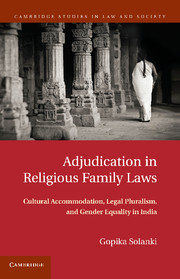 Adjudication in Religious Family Laws
Adjudication in Religious Family Laws Book contents
- Frontmatter
- Contents
- List of Figures
- List of Tables
- Preface
- Acknowledgments
- Abbreviations
- Glossary
- 1 Introduction
- 2 The Shared Adjudication Model
- 3 State Law and the Adjudication Process
- 4 Making and Unmaking the Conjugal Family
- 5 Juristic Diversity, Contestations over “Islamic Law,” and Women's Rights
- 6 Conclusion
- Appendix
- Bibliography
- Index
- CAMBRIDGE STUDIES IN LAW AND SOCIETY
6 - Conclusion
Published online by Cambridge University Press: 03 May 2011
- Frontmatter
- Contents
- List of Figures
- List of Tables
- Preface
- Acknowledgments
- Abbreviations
- Glossary
- 1 Introduction
- 2 The Shared Adjudication Model
- 3 State Law and the Adjudication Process
- 4 Making and Unmaking the Conjugal Family
- 5 Juristic Diversity, Contestations over “Islamic Law,” and Women's Rights
- 6 Conclusion
- Appendix
- Bibliography
- Index
- CAMBRIDGE STUDIES IN LAW AND SOCIETY
Summary
This book poses the following questions: How do accommodative arrangements advocating cogovernance by state and society in legally plural societies impact on the interactions between and within religious groups and other societal bodies? How do they shape gender equality in the family? What is the nature of state-society interactions in the adjudication of religious laws in legally plural societies? The study aims to describe, understand, and, in the end, explain the functioning of the Indian policy of legal pluralism as an accommodative measure in the governance of marriage and divorce among Hindus and Muslims. The Indian state has adopted what I call a shared adjudication model in which the state and a broad range of societal bodies share adjudicative authority. In other words, the Indian state, in the governance of religious family law, adopts the strategy of “regulated autonomy” by which it incorporates religious groups into the governance of the family and circumscribes their sphere of autonomy. This strategy is an outcome of the Indian state's desire to shape the family and gender from above while balancing the plural demands of groups. The model has been crafted from above but it been creatively interpreted, shaped, and used by societal actors and bodies, its boundaries challenged, changed, and stretched on the ground.
Given that the Indian state recognizes state and nonstate laws and allows adjudication in formal and informal arenas, how do we distinguish between state and societal laws and characterize interactions between official and unofficial legal arenas?
- Type
- Chapter
- Information
- Adjudication in Religious Family LawsCultural Accommodation, Legal Pluralism, and Gender Equality in India, pp. 325 - 348Publisher: Cambridge University PressPrint publication year: 2011
